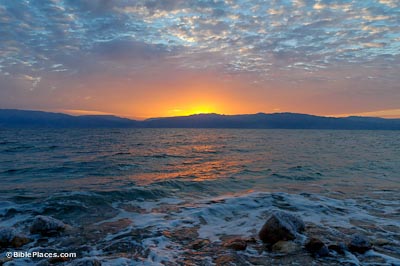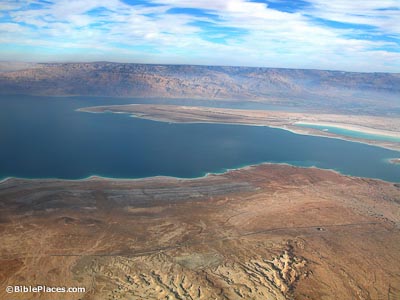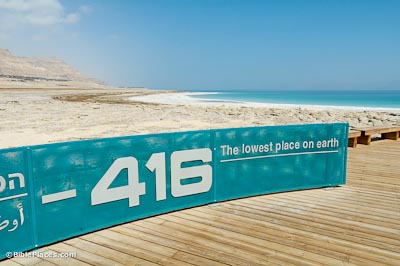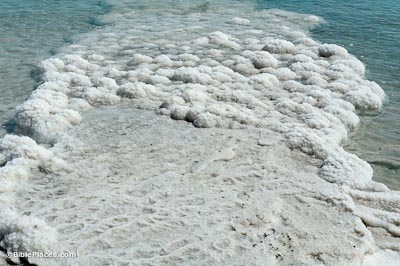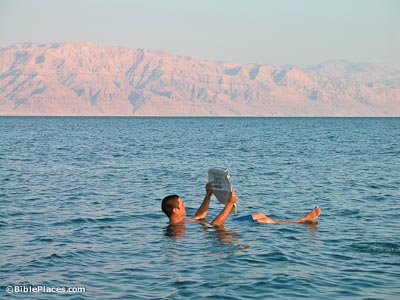Known in the Bible as the “Salt Sea” or the “Sea of the Arabah,” this inland body of water is appropriately named because its high mineral content allows nothing to live in its waters. Other post-biblical names for the Dead Sea include the “Sea of Sodom,” the “Sea of Lot,” the “Sea of Asphalt” and the “Stinking Sea.” In the Crusader period, it was sometimes called the “Devil’s Sea.” All of these names reflect something of the nature of this lake.
Dead Sea
Biblical Period
The Dead Sea, unlike the Sea of Galilee to the north, does not figure prominently in the biblical narratives. Its most important role was as a barrier, blocking traffic to Judah from the east. An advancing army of Ammonites and Moabites apparently crossed a shallow part of the Dead Sea on their way to attack King Jehoshaphat (2 Chr 20). Ezekiel has prophesied that one day the Dead Sea will be freshwater and fishermen will spread their nets along the shore.
Lowest Point
The Dead Sea is located in the Syro-African Rift, a 4000-mile (6500-km) fault line in the earth’s crust. The lowest point of dry land on earth is the shoreline of the Dead Sea at 1300 feet (400 m) below sea level. That the lake is at the lowest point means that water does not drain from this lake. Daily, 7 million tons (6.4 mil t) of water evaporate but the minerals remain, causing the salt content to increase. Figures for the Dead Sea’s salinity today range from 26–35%.
Mineral-Rich
Nearly ten times as salty as the world’s oceans and twice as saline as the Great Salt Lake in Utah, the Dead Sea is rich with minerals. The Dead Sea Works company on the southwest side of the lake employs 1600 people around the clock to harvest the valuable minerals from the water. Potash is the most valuable of those extracted today and is used in the manufacture of fertilizer. The best article on the minerals in the Dead Sea is in the Encyclopedia Britannica.
Healthy Water
The unique concentration of the Dead Sea waters has long been known to have medicinal value. Aristotle, the Queen of Sheba, King Solomon, and Cleopatra were all familiar with this. Modern doctors still prescribe patients with skin ailments to soak in the waters of the Dead Sea. Because of the dropping level of the Dead Sea, the southern end is no longer under water, except for that which is channeled by aqueducts for the purpose of extracting minerals.

Download all of our Judah and the Dead Sea photos!
$39.00 $49.99 FREE SHIPPING
Related Websites
At BiblePlaces.com, see the related sites of En Gedi, Masada, Qumran, Qumran Caves, Jericho, and the Judean Wilderness. For historical images of the Dead Sea, see Life in the Holy Land.
Dead Sea (Encyclopedia Britannica) A great overview of the area, along with some fascinating photos of the water loss at the southern end.
The Dead Sea: Top Tips for Your First Visit (Lonely Planet) Looking for a helpful guide to tourism here? You’ve found it.
Dead Sea in the Bible (DeadSea.com) Basic information about the Dead Sea in the context of the Bible.
Dead Sea (Catholic Encyclopedia) Highlights the biblical significance of the site while clearly describing the geographical and physical properties of the sea and surrounding area.
The Dead Sea Research Center (The Minerva Dead Sea Research Center) Although this website is very dated, it has some interesting information about the Dead Sea and its basin, including a special tab for “Research.”
Everything You Want to Know About the Dead Sea (DeadSea.com) Question and answer format gives interesting answers to common questions about the Dead Sea’s depth, composition, etc.
Dead Sea Keeps Falling (BBC News) An interesting news story from 2002 reporting on the findings of the European Space Agency in their survey of the region.
Dead Sea Drying: A New Low-Point for Earth (BBC News) This 2016 article discusses the merit of the Dead Sea, and its continually dropping water levels.
Geography of Israel: The Dead Sea (Jewish Virtual Library) Gives geographical and tourist information about the Dead Sea region.
For Dead Sea, a Slow and Seemingly Inexorable Death (Washington Post) Fascinating 2005 article on the steady decline of the water level of the Dead Sea, with numerous useful facts.
The Dead Sea: What is deader than dead? (Ferrell Jenkins) This 2016 post from Jenkins includes a nice photo of some of the sinkholes lining the Dead Sea.
